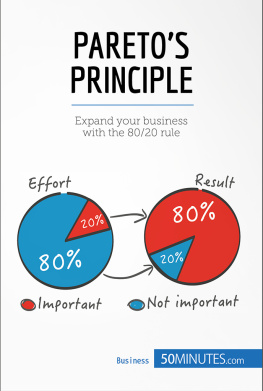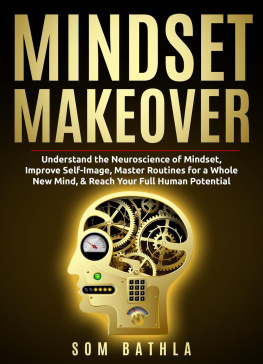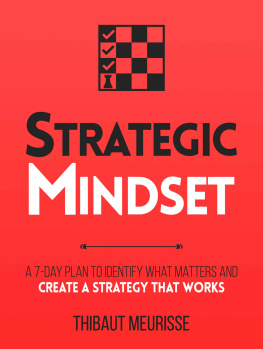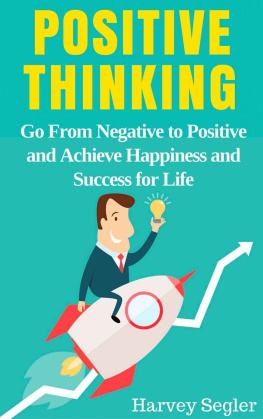Title Page
ACHIEVE MORE
WITH PARETOS LAW
A Book By
Sobaca Limited
Publisher Information
Achieve More with Paretos Law
Published in 2010 by
Sobaca Limited
5 Fleet Place
EC4M 7RD
www.sobaca.com
Digital Edition converted and distributed by
Andrews UK Limited
www.andrewsuk.com
This book is sold subject to the condition that it shall not, by way of trade or otherwise, be lent, resold, hired out or otherwise circulated without the publishers prior written consent in any form of binding or cover other than that in which it is published, and without a similar condition being imposed on the subsequent purchaser.
Copyright Sobaca Limited
Disclaimer
This publication contains the opinions and ideas of the authors. It is not a recommendation to purchase or sell any of the investments, products or services herein discussed.
Commentary and information is not intended to amount to advice and you should not rely on it without seeking independent advice for your circumstances. Any reliance that you place on the accuracy, completeness, currency or reliability of any information in this book is at your own risk. We do not accept any responsibility or liability for any errors or omissions that the book may contain.
We will exercise all reasonable skill and care in providing this book and the information in it. However, the information provided in this book is provided on an as is basis. This book is provided without representation or warranty of any kind (whether express or implied (whether by common law, custom, statute or otherwise)) including, without limitation, any representations or warranties as to the accuracy, completeness, currency or reliability of the information in the book or that the book will meet your requirements.
The authors and publisher specifically disclaim any responsibility for any liability, loss, risk, claim or damage (professional or otherwise) which is incurred as a consequence, directly or indirectly, of the use and application of any of the content or information in this book, howsoever arising whether in contract, tort (including negligence), strict liability or otherwise. Laws and regulations are complex and liable to change and readers should check the current position with relevant legal advisors and/or relevant authorities before making personal arrangements. Nothing in this disclaimer shall exclude or limit our liability for any liability which cannot be excluded or limited under applicable law.
Introduction
Imagine this is you: someone in a loving relationship with a partner they long to spend time with. Someone who bases their work on what they are good at and what they enjoy. Someone, who finds success comes easily. Someone who never has to hurry and knows that time is a friend and not an enemy. Someone, who has time to think. Who awaits opportunities others are too busy to see. Who puts the odds in their favour. Someone who gets the most out of leisure time by concentrating on activities they enjoy most, who spends time with people they like and is optimistic and ambitious to achieve all that they can. Someone who loves life.
Imagine that this someone is you, because it can be.
If you think this is too good to be true you are only proving this description doesnt apply to you. Yet!
Look around you and you will see far too many people who live in a world of compromise. They spend a lot of their time with people they dont really like, have jobs they are not suited to, ones that dont make use of their talents and then they spend their free time doing things they dont enjoy. It may sound crazy, but it is true.
This book will show how you can learn to think in a way that encourages you to take the time to stop and ask yourself what it is that makes you happy. In doing so you will be able to make decisions that will improve your life.
You will learn how it is possible to work in a profession you enjoy and one that makes use of your talents. You will also learn how to spend time with the people you care about most and you will be encouraged to spend your free time on things you love to do.
It is an optimistic message because it is based on optimistic thinking. It suits those of you that are looking to enjoy life to the full.
Lets now move on and explore the principle that we will base our methods on. We have to fully understand all its implications before we can make good use of it.
Chapter1
The Pareto principle
We need to go back to the 19 th century to find the person whose work will eventually form the foundation of the principle we will use. We are looking for a man named Wilfred Pareto.
Pareto was an Italian economist who, in the course of his work, undertook a commission to study wealth and income streams throughout England. On completing his work, he began to notice a pattern emerging. His research was showing that 80% of the entire nations wealth was in the hands of only 20% of the population. This seemed an unusually large imbalance and so to make sure that this wasnt just a one-off, he repeated the research, only this time he looked at data from earlier time periods. And to make extra sure, he performed similar studies on other countries and then compared the information.
The results were consistent. No matter what country he looked at or what time frame he used, the pattern was always the same: 80% of a nations wealth was held by 20% of the population.
Wilfred Pareto had inadvertently discovered something of considerable value. Sadly it would be of mixed blessings to him, as no one paid too much attention to it at the time. But it did come to be known as the Pareto principle or Paretos law and for that we can thank him.
Wilfred Pareto, through his work, gave us the principle of 80/20.
If we come back now to the present day and look for current examples, we can see the Pareto principle shows us that 80% of all road accidents are caused by 20% of the drivers and that 20% of the carpets in your house suffer 80% of the wear and tear. You will find that 20% of the clothes in your wardrobe are worn 80% of the time. There is evidence of it all around you. You just have to know how to look.
Remember that, at the time, Paretos principle was largely ignored. This was because nobody really thought of it as anything much more than research. They hadnt considered any wider implications and so for decades it only attracted passing interest at best. That is until someone realised how they could make money from it.
The next few chapters will break down the 80/20 principle so that you fully understand it. Afterwards, you will see how you can use it to enrich your life.
Chapter 2
Principle examples
In the 1960s, IBM was the computer giant of the time and it was they who first discovered that by applying Paretos principle to the design of their machines they could create a much better product that was more profitable.
After applying the principle, they soon realised that a person working with a computer spent 80% of their time using just 20% of the software that was available on it. Clearly this was extremely inefficient as it meant that the majority of the software, while hardly being used, still took up a lot of memory space. What IBM resolved to do was completely rewrite the operating software for their computers. They concentrated on placing the emphasis on the most used 20% and less on what had been the hardly used 80%. The results were dramatic. Faster, more efficient and easier to use computers that their customers loved.










